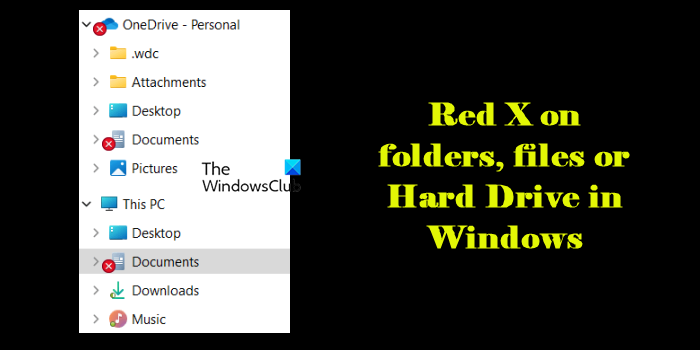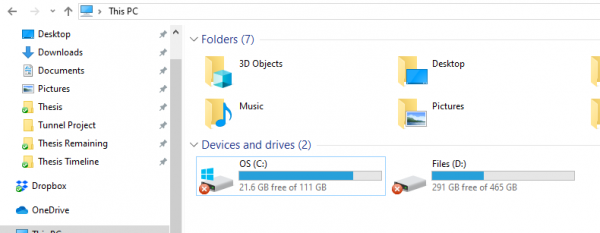According to several reports, a rare error of Local Disk drive partitions has a red circle with an X in their icons. The cause of this error is still unknown, but it usually means that the file folder or disk or contents are not refreshing, updating, or syncing. Several methods help in troubleshooting this error. The main thing to note here is that it can occur on local disks, disks mapped on a network as well as files and folders.

Red X on folders, files or Hard Drive
If you see the red X icon overlay then following these suggestions may help you. If it is happening for desktop icons, simply refreshing the desktop could help:
- Reinstall your Cloud service app
- Disconnect the drive in case of Mapped drives
- Update your computer and BIOS.
- Run CHKDSK.
- Clear icon cache.
- Disable Hard disk Write Protect.
- Scan with an Antivirus.
- If it is just OneDrive?
![]()
1] Reinstall your Cloud service app
If you have OneDrive, Dropbox, etc. installed on your computer, then it might be the one causing this issue.
You need to either update these software or if that doesn’t help, uninstall it and fresh-install its latest version.
2] Disconnect the drive in case of Mapped drives
Open the Windows File Explorer.
On the top ribbon, select the down arrow and select Disconnect network drive.

It will open a new dialog box that will list the letters allocated to partitions mapped will be listed.
Select OK.
And now all the Mapped drives will be disconnected.
You can then Map it back if there is a need.
Read: How to remove Green Check Marks on Desktop Icons in Windows
3] Update your computer and BIOS
You need to update your copy of Windows and then update your computer’s BIOS.
Reboot your computer. This has proven to have fixed this error for many.
4] Run CHKDSK
We will use the command line to run ChkDsk. Run CMD as an Administrator and execute the following command:
chkdsk <Drive Letter>: /f /r /x /b
It will either start checking for errors and fixing them, or it will show up a message saying –
Chkdsk cannot run because the volume is in use by another process, Would you like the schedule this volume to be checked the next time the system restarts? (Y/N)
Hit Y to schedule the Disk Check the next time the system restarts.
Reboot your computer and let the chkdsk run.
See if this has helped.
5] Clear icon cache
To clear the Icon cache, open the Windows Task Manager.
Scroll down to Windows Explorer. Right-click on the listing and select End Task.
Run the Windows Command Prompt as an Admin.
Execute the following commands in the given order:
cd /d %userprofile%\AppData\Local attrib –h IconCache.db del IconCache.db start explorer
Your icon cache will now clear and be rebuilt.
6] Disable Hard disk Write Protect

Some folks have reported that they had to disable Write Protection. See if that helps you.
7] Scan with an Antivirus
Sometimes viruses can damage a file and result in errors like this too.
It is advised that you perform a deep, full scan on your computer using the antivirus installed on your computer.
8] If it is just OneDrive?
If this error is only visible on the OneDrive icon and in the contents of the OneDrive folder, there might be chances that there is an issue with the OneDrive syncing. This post shows how to fix this & other OneDrive errors.
We hope you found the steps easy to follow and that you were successful in resolving the issue.
How to remove red x on desktop icons in Windows 11?
To remove the Red X on desktop icons in a Windows 11/10 PC, check the icon file path in the registry to make sure it is correct, replace the corrupt icon with a valid icon file, ensure you have enough disk space on your drive, run a malware scan to identify and remove any malicious software that may be causing the red X, or if you have a restore point before the occurrence of the red cross, use it to revert your PC to a previous working state.
What does red x mean?
A red cross (X) on a Windows 11/10 PC indicates a problem with the app, folder, or file to which it is associated. If the cross is on a cloud storage service icon, it indicates a problem syncing file or folder data. Suppose it is on a file or folder icon. In that case, it indicates that the file or folder is either corrupted or unavailable (if located on a network drive that’s currently not accessible). Sometimes, the red cross indicates that the user does not have the necessary permissions to access the file or folder. A red cross can also indicate low disk space, preventing files from being saved or synchronized properly.